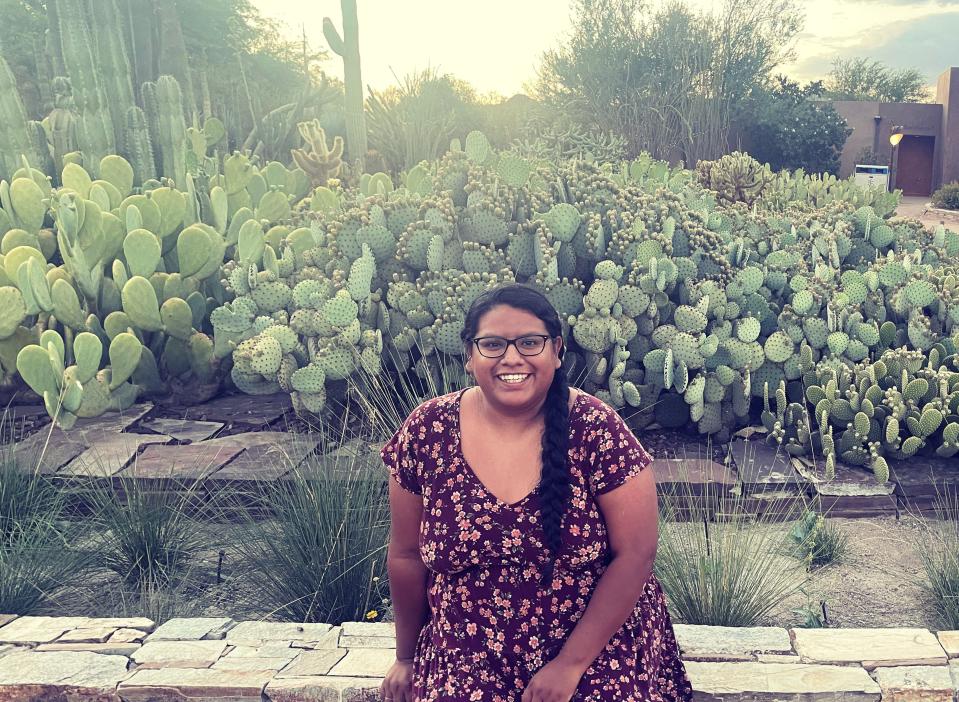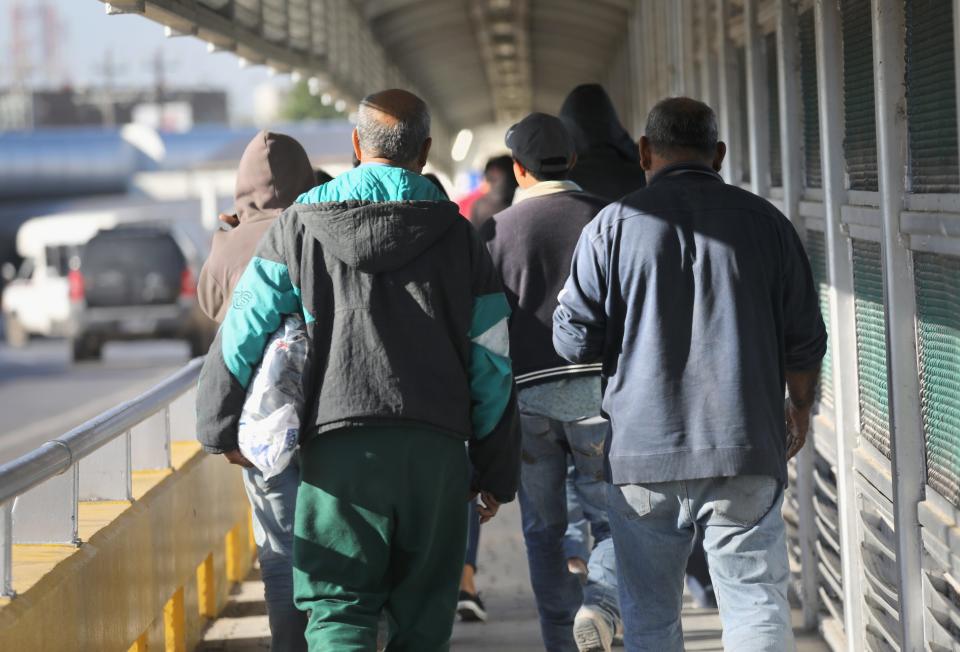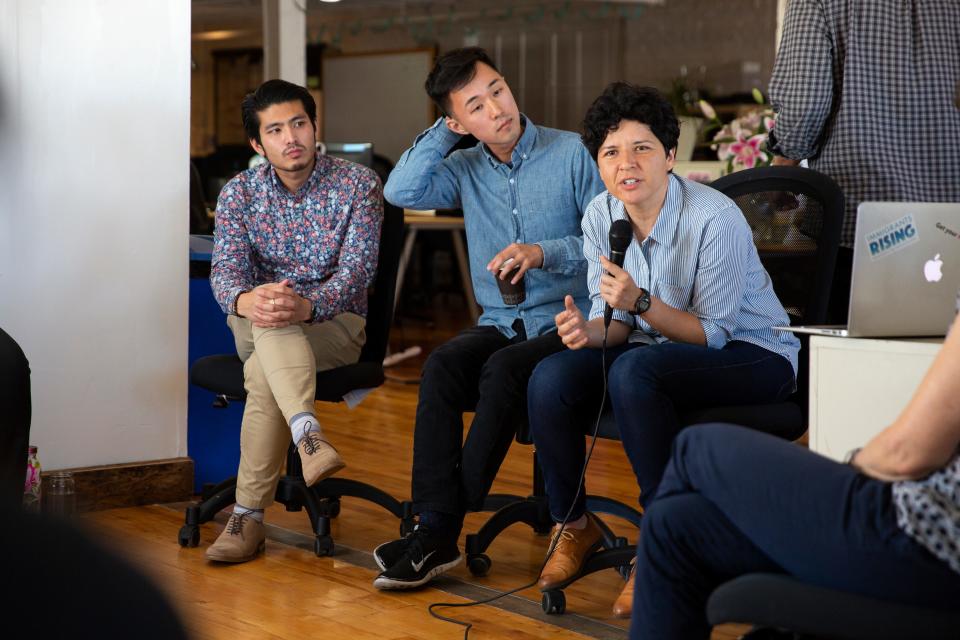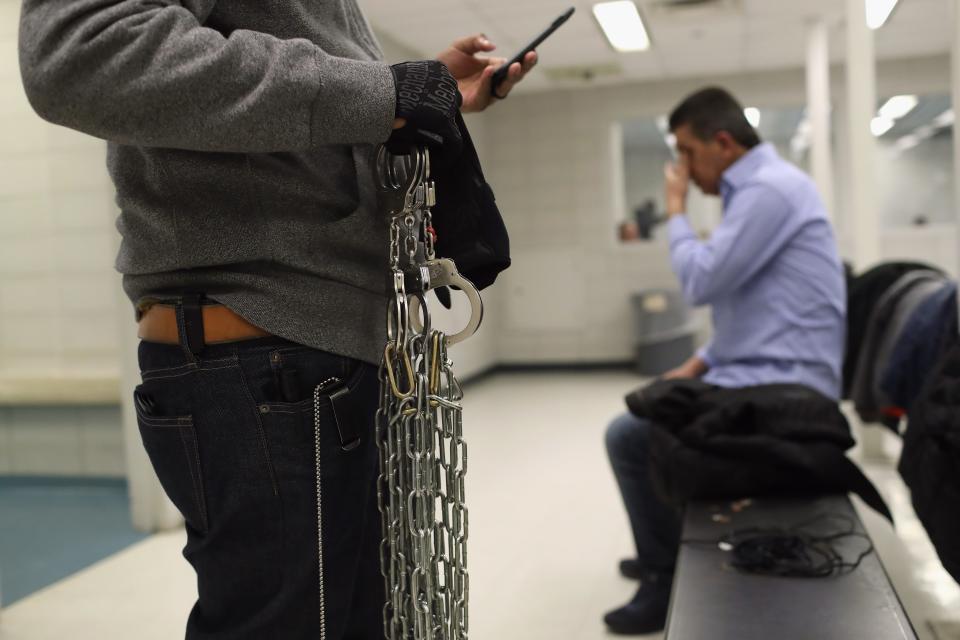They paid taxes. Now undocumented Latinos are aging without savings, government care
In 1998, Noe Ramirez crossed into the United States from Mexico, hoping to earn enough to buy a new taxi to replace the sputtering cab he drove in Mexico City. The part-time musician found construction work in Houston and played guitar on the weekends.
One morning as he rode his bike to work, he was hit by a drunken driver. The driver fled, leaving him bleeding on the street, his spinal cord crushed. After being hospitalized, he was taken in by a local shelter for undocumented migrants and received medical care through a county program for low-income residents.
Ramirez knows he might not be as lucky were something to happen to him again. Though he and his wife live on their own these days, Ramirez, 53, who uses a wheelchair, wonders how the couple will grapple with getting older without the retirement and health benefits enjoyed by U.S. citizens.
“Every month, me and my wife save some money,” Ramirez said. “But I know it will not be enough for my future, because I have no insurance.”
Like Ramirez, millions of other unauthorized Latino immigrants came to the United States when they were young, able-bodied and hopeful, seeking better livelihoods than they could find back home. They worked in construction, agriculture and landscaping; they staffed kitchens and bars or cleaned houses.
They had families, found community, settled down. And years passed.
Now, as their bodies age and they head into years when many others are pondering retirement, older undocumented immigrants have few resources to rely on. Elder care often relies on public benefits for which many undocumented immigrants are not eligible, despite the fact that most have paid taxes for years.
“They have no way to draw on that money they’ve paid into the system,” said Tony Payan, executive director of the Center for the U.S. and Mexico at Rice University in Houston.
A report from New American Economy, a bipartisan nonprofit, estimated that undocumented workers generated a surplus of $100 billion in Social Security program funds in the decade leading up to 2018 and $35 billion in the Medicare Trust Fund from 2000 to 2011, none of which they were eligible to get back in benefits.
That has left many undocumented immigrants working long past the point of when their bodies can handle it.
Activists share their stories: In Chicago, an older undocumented Latina suffers from multiple chronic conditions, unable to perform daily tasks without severe pain but ineligible to see a primary care doctor. In Houston, an undocumented Honduran woman and longtime U.S. resident copes with the deportation of her husband, unable to work because of arthritis in her spine – but unable to file for disability benefits. And in San Jose, California, an undocumented man in the United States for 32 years suffering from severe diabetes continues to work at an apartment complex, cleaning yards and doing maintenance.
“It’s common to say, ‘Oh, they’re a burden to society and taking advantage of services and don’t pay taxes,’ but it’s actually quite the opposite,” Payan said. “These people are contributing much more than they’re taking in. And when it comes to old age, when they’re really needing those savings and that medical coverage, they just don’t have it.”
Health advocates say the situation presents a looming disaster, not only for the immigrants but for the system at large.
“The movement of the population into senior years has substantial implications for public systems of health, health care and social services throughout the state,” read a 2020 report from Rush University Medical Center in Chicago. In Illinois, the older undocumented population is expected to increase thirteenfold by decade’s end.
“The public policy barriers that currently block undocumented immigrants from accessing aging services will inevitably lead to a public health crisis,” the report said.

Padraic Stanley, chair of the medical center’s Immigrant Working Group and co-author of the report, said chronic conditions suffered by the population will compound and worsen without access to health care services, straining already overloaded sources of help – family, charity care services and emergency rooms.
“It will be a public health crisis by 2030 because the patchwork support system we provide is not going to be feasible by then,” Stanley said.
If measures aren’t taken, he said, the burden will fall on the undocumented themselves – as well as family members, health care systems and ultimately the public.
“From emergency room visits, hospitalizations and unpaid debt that hospitals accrue, the taxpayers will end up paying,” he said.
Latino population getting much older
The undocumented Latino population mushroomed throughout the 1990s and early 2000s, pushing the number of unauthorized immigrants to about 12.2 million in 2007, according to the Pew Research Center. The majority come from Mexico and Central America.
With the job losses of the Great Recession and increased deportations under the Obama and Trump administrations, the figure dipped to about 10.5 million before the most recent influx of migrants. Mexican migrants accounted for nearly all of that decline, according to the Pew Research Center.
Today’s undocumented population is more settled than in the past, said Manuel Pastor, a sociology professor at the University of Southern California. Fifteen years ago, he said, about a third had lived in the United States for a decade or more; that figure is now closer to two-thirds.
“One reason there’s been a lengthening amount of time is that border crossing has become so much harder,” Pastor said. “It used to be someone could go back every couple of years and refresh their ties, make sure their 'tía' and 'tío' knew who they were. But the longer someone has been away, the less tight their connections to their families and villages there are.”

Estimates of those 55 and older range from 7% to 12% of the overall undocumented population. A report published last year in The Journal of Gerontology estimated 491,000 undocumented Latinos in that age group – but the study estimated that number will grow by 2038 to 3.8 million, about 40% of the population.
“This cohort is growing rapidly,” said Arturo Vargas Bustamante, a professor of health policy and management at the University of California, Los Angeles. “Over the next two or three decades, we will see the numbers explode.”
At Rice, the Center for the United States and Mexico estimates that undocumented migrants account for about 1.6 million of Texas' overall population of about 30 million.
“When you account for all the services that they use and the costs to the state versus their contribution in terms of taxes, the plus to Texas is half a billion dollars,” said Payan. “And that doesn’t even include their actual contribution to the economy at large.”
Undocumented immigrants are ineligible for elder benefits that require Social Security numbers to receive, including Supplemental Nutrition Assistance Program funds and programs that can provide homecare, adult day care, mental health services and transportation services.
“Undocumented folks have a much harder time accessing food stamps and other kinds of government benefits,” said Sarah Portnoy, a Latino food studies professor at the University of Southern California.
Caseworkers have to get creative as they link undocumented clients to community resources so as not to out them – for instance, seeking agencies that will take nontraditional forms of identification or documentation to qualify. It’s a tricky balance that becomes shakier in emergency situations, such as if an older undocumented adult is having a mental breakdown.
“We have to hesitate,” said Miriam Camero, vice president of social programs for the Refugee and Immigrant Center for Education and Legal Services (RAICES) in San Antonio, Texas. “It’s like, do we call 911? We have to make sure we’re not having them face deportation because of our actions.”

For many, returning to their homeland after spending their working years in the United States is not a viable option.
“They’ve lost their cultural capital and their contacts, and they certainly did not accrue any of the benefits they might have acquired there,” Payan said. “They find themselves in a situation where they didn’t accrue any benefits in their own country and they didn’t accrue any in the U.S., and now they’re not entitled to anything.”
'In survival mode, all the time'
A July 2021 study showed that while immigrants, on the whole, enjoyed better health than U.S.-born citizens, the same did not hold true for the undocumented.
“Across the board, undocumented immigrants have disproportionately higher health risks,” the authors said, noting that twice as many of those 65 and older described their health as “fair or poor” compared with U.S.-born citizens. Meanwhile, just 29% reported being in “very good” or “excellent” health, compared with 54% of native U.S. citizens.
Undocumented workers often labor in front-line and low-wage jobs and live in overcrowded housing conditions, both of which are risk factors for higher COVID-19 mortality.
During the coronavirus pandemic, Payan said, the center found that many who were exposed to the virus didn’t seek medical care.
“Many just stayed home and suffered, and many died,” he said. “They had no access to health care or were afraid to seek it out. That was a very serious warning to us that when they’re old and have chronic conditions and are dealing with the process of aging that they will simply stay home. And it’s family members who will have to figure out who’s going to take care of Grandpa or Grandma.”
In 2020, about 42% of undocumented immigrants were uninsured compared with 8% of U.S. citizens, according to the Kaiser Family Foundation.

The disparities also affect mental health. A life spent looking over one’s shoulder compounds one’s fragility, aggravating stress that often goes untreated – not only because most can’t access mental health services but because of the cultural stigma attached to such issues or fear of discussing one’s situation.
“They’re almost in survival mode, all the time,” said Nancy Rodriguez, a clinical psychologist in Oakland, California, who works with undocumented clients through her practice, Healing Corazones. “There’s the fear of deportation, that something is going to happen to you and that your livelihood is going to be taken away. And when you’re in survival mode, there’s a level of not wanting to talk about what’s going on because it doesn’t feel safe.”
That can exacerbate levels of depression, anxiety and trauma-related diagnoses, Rodriguez said. For those who left homelands because of violence and war, stress and depression can set in as they reflect on their lives.
Even those with families or communities in the United States might shut down rather than share their feelings, she said.

Some undocumented laborers have also been subjected to abuse, discrimination and unfair practices such as wage withholding.
“They're taught to be treated as less of a human being because they don’t have status,” said Camero, of San Antonio’s RAICES. “That absolutely weighs on a person year after year. When does a person like that feel relaxed and at peace?”
Children of immigrants will face hard choices
Because their status has generally relegated them to menial jobs, undocumented elders have been less able to compile wealth over time. For many, retirement is a mirage that dissipates as it gets closer.
“When people stop working, they are without a nest egg,” said Pastor, the sociology professor. “That’s going to be a big burden as people move into retirement age and are still here.”
Though some can turn to charity health care and philanthropic organizations, that burden falls mainly on the families with whom most of them live. According to the Rush University Medical Center study, about two-thirds of undocumented Latinos live in multigenerational households, and 8% live alone.
As a result, the working children of many undocumented elders will face hard choices.
“They may support their senior parents but then be unable to afford a house or start a business,” Pastor said. “They’re facing a cumulative disadvantage, not able to create and garner wealth and less able to support their kids’ college education. It’s a burden they might willingly take on, but it has mobility consequences for that generation.”
Elders unable or unwilling to depend on family members simply keep working as they reach retirement age, aggravating existing health conditions through physically demanding and often dangerous labor. Jobs likelier to draw immigrants are linked to higher rates of workplace injury – but many incidents go unreported out of fear of drawing attention from authorities.

“Often, people are forced to continue working until it is physically impossible,” said Tovia Siegel, campaign director for Healthy Illinois, a movement working to institute health coverage for all state residents regardless of residency status. “They don’t have coverage for primary and preventative care, and either they don’t seek medical care when they need it, or they have to choose between paying for care or for other necessities like housing and food.”
Years of difficult and sometimes dangerous labor take their toll, Camero said.
“We’ve had clients who were blinded and had fingers chopped off because of construction work, or paralyzed because they fell from a ladder,” she said. “Even with maid services, people have a lot of lung issues because of chemicals, or skin issues because of all the bleach they’ve touched.”
Others who have spent years in the restaurant industry have worked odd hours, maybe juggling two jobs.
“It’s just straight-up exhaustion, not conducive to a healthy human,” Camero said. “Tell me you would send your grandmother to do any of those things. It’s unfathomable.”
'They have given their productive lives'
To address the need, states such as California and Illinois with some of the nation’s largest numbers of immigrants have launched programs offering medical care to certain age groups, including the elderly, regardless of immigration status.
But advocates say the most effective way to head off the growing crisis is to grant aging undocumented workers access to federal health programs, as well as a pathway to legal residency.
“What we have to do is allow them to get into Medicare or Medicaid,” said Vargas Bustamante, of UCLA. “And we need to legalize them somehow. Otherwise, the inequities will become much more widespread as that population grows. They have given their productive lives to the U.S., and the least we can do is integrate them into the country as they grow old.”
Ramirez, the former Mexico City taxi driver in Texas, said that despite the limitations brought on by his accident, he has been able to build a good life: He and his wife now have a house, and their daughter is married and is a registered nurse in Houston. In 2005, the county program that provided medical supplies to him and others discontinued the practice, leaving other undocumented recipients scrambling.
After meeting to discuss options, Ramirez and others realized they were their own best resource, holding raffles and car washes and selling roses at busy intersections to help pay for the wheelchairs, catheters and other equipment they needed. They formed a local nonprofit called Living Hope Wheelchair Association, serving immigrants in similar situations.
Still, Ramirez said the prospect of old age is worrisome. For him, there is no Social Security, pension or retirement plan.
Having regained use of his arms, he sells Living Hope T-shirts after church services and offers guitar lessons to make money. His wife cleans houses and provides his caregiving, tending to his bedsores and helping him with everyday tasks.
At least, Ramirez said, they can rely on their daughter. He knows that for other older undocumented people, family may not be an option. And for now, he plans to keep working as long as he can.
“At least I can give guitar classes,” he said. “For that, it doesn’t matter if I am old. I will keep working.”
This article originally appeared on USA TODAY: Undocumented immigrants can't access government healthcare as they age

 Yahoo Sports
Yahoo Sports 